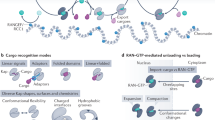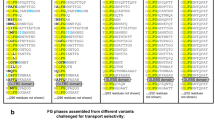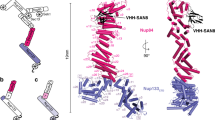Abstract
Transport factors in the karyopherin-β (also called importin-β) family mediate the movement of macromolecules in nuclear–cytoplasmic transport pathways. Karyopherin-β2 (transportin) binds a cognate import substrate and targets it to the nuclear pore complex. In the nucleus, Ran˙GTP binds karyopherin-β2 and dissociates the substrate. Here we present the 3.0 Å structure of the karyopherin-β2–Ran˙GppNHp complex where GppNHp is a non-hydrolysable GTP analogue. Karyopherin-β2 contains eighteen HEAT repeats arranged into two continuous orthogonal arches. Ran is clamped in the amino-terminal arch and substrate-binding activity is mapped to the carboxy-terminal arch. A large loop in HEAT repeat 7 spans both arches. Interactions of the loop with Ran and the C-terminal arch implicate it in GTPase-mediated dissociation of the import-substrate. Ran˙GppNHp in the complex shows extensive structural rearrangement, compared to Ran˙GDP, in regions contacting karyopherin-β2. This provides a structural basis for the specificity of the karyopherin-β family for the GTP-bound state of Ran, as well as a rationale for interactions of the karyopherin–Ran complex with the regulatory proteins ranGAP, ranGEF and ranBP1.
This is a preview of subscription content, access via your institution
Access options
Subscribe to this journal
Receive 51 print issues and online access
$199.00 per year
only $3.90 per issue
Buy this article
- Purchase on Springer Link
- Instant access to full article PDF
Prices may be subject to local taxes which are calculated during checkout






Similar content being viewed by others
References
Pemberton, L. F., Blobel, G. & Rosenblum, J. S. Transport routes through the nuclear pore complex. Curr. Opin. Cell Biol. 10, 392– 399 (1998).
Nehrbass, U. & Blobel, G. Role of the nuclear transport factor p10 in nuclear import. Science 272, 120– 122 (1996).
Ribbeck, K., Lipowsky, G., Kent, H. M., Stewart, M. & Gorlich, D. NTF2 mediates nuclear import of Ran. EMBO J. 17, 6587–6598 (1998).
Conti, E., Uy, M., Leighton, L., Blobel, G. & Kuriyan, J. Crystallographic analysis of the recognition of a nuclear localization signal by the nuclear import factor karyopherin alpha. Cell 94, 193–204 ( 1998).
Albertini, M., Pemberton, L. F., Rosenblum, J. S. & Blobel, G. Anovel nuclear import pathway for the transcription factor TFIIS. J. Cell Biol. 143, 1447–1455 (1998).
Kaffman, A., Rank, N. M. & O'Shea, E. K. Phosphorylation regulates association of the transcription factor Pho4 with its import receptor Pse1/Kap121. Genes Dev. 12, 2673–2683 (1998).
Kaffman, A., Rank, N. M., O'Neill, E. M., Huang, L. S. & O'Shea, E. K. The receptor MsN5 exports the phosphorylated transcription factor Pho4 out of the nucleus. Nature 396, 482–486 ( 1998).
Rexach, M. & Blobel, G. Protein import into nuclei: association and dissociation reactions involving transport substrate, transport factors, and nucleoporins. Cell 83, 683– 692 (1995).
Siomi, M. C. et al. Transportin-mediated nuclear import of heterogeneous nuclear RNP proteins. J.Cell Biol. 138, 1181– 1192 (1997).
Izaurralde, E., Kutay, U., von Kobbe, C., Mattaj, I. W. & Gorlich, D. The asymmetric distribution of the constituents of the Ran system is essential for transport into and out of the nucleus. EMBO J. 16, 6535–6547 ( 1997).
Bischoff, F. R. & Ponstingl, H. Catalysis of guanine nucleotide exchange of Ran by RCC1 and stimulation of hydrolysis of Ran-bound GTP by Ran-GAP1. Methods Enzymol. 257, 135–144 (1995).
Bonifaci, N., Moroianu, J., Radu, A. & Blobel, G. Karyopherin beta2 mediates nuclear import of a mRNA binding protein. Proc. Natl Acad. Sci. USA 94, 5055–5060 ( 1997).
Pollard, V. W. et al. Anovel receptor-mediated nuclear protein import pathway. Cell 86, 985–994 ( 1996).
Fridell, R. A., Truant, R., Thorne, L., Benson, R. E. & Cullen, B. R. Nuclear import of hnRNP A1 is mediated by a novel cellular cofactor related to karyopherin-beta. J. Cell Sci. 110, 1325–1331 (1997).
Andrade, M. A. & Bork, P. HEAT repeats in Huntington's disease protein. Nature Genet. 11, 115– 116 (1995).
Stewart, M., Kent, H. M. & McCoy, A. J. The structure of the Q69L mutant of GDP-Ran shows a major conformational change in the switchII loop that accounts for its failure to bind nuclear transport factor2 (NTF2). J. Mol. Biol. 284, 1517–1527 (1998).
Scheffzek, K., Klebe, C., Fritz-Wolf, K., Kabsch, W. & Wittinghofer, A. Crystal structure of the nuclear Ras-related protein Ran in its GDP-bound form. Nature 374, 378–381 (1995).
Sheldrick, G. M., Dauter, Z., Wilson, K. S., Hope, H. & Sieker, L. C. The application of direct methods and Patterson interpretation to high-resolution native protein data. Acta Crystallogr. D 49, 18–23 (1993).
Groves, M. R., Hanlon, N., Turowski, P., Hemmings, B. A. & Barford, D. The structure of the protein phosphatase 2A PR65/A subunit reveals the conformation of its 15 randomly repeated HEAT motifs. Cell 96, 99–110 ( 1999).
Huber, A. H., Nelson, W. J. & Weis, W. I. Three-dimensional structure of the armadillo repeat region of β-catenin. Cell 90, 871– 882 (1997).
Malik, H. S., Eickbush, T. H. & Goldfarb, D. S. Evolutionary specialization of the nuclear targeting apparatus. Proc. Natl Acad. Sci. USA 94, 13738–3742 (1997).
Richards, S. A., Lounsbury, K. M. & Macara, I. G. The C terminus of the nuclear RAN/TC4 GTPase stabilizes the GDP-bound state and mediates interactions with RCC1, RAN-GAP, and HTF9A/RANBP1. J. Biol. Chem. 270, 14405– 14411 (1995).
Vetter, I. R., Nowak, C., Nishimoto, T., Kuhlmann, J. & Wittinghofer, A. Structure of a Ran-binding domain complexed with Ran bound to a GTP analogue: implications for nuclear transport. Nature 398, 39–46 ( 1999).
Pai, E. F. et al. Structure of the guanine-nucleotide-binding domain of the Ha- ras oncogene product p21 in the triphosphate conformation. Nature 341, 209–214 ( 1989).
Hidea, M. et al. Amonoclonal antibody to the COOH-terminal acidic portion of Ran inhibits both the recycling of Ran and nuclear protein import in living cells. J. Cell Biol. 144, 645– 655 (1999).
Kutay, U., Izaurralde, E., Bischoff, F. R., Mattaj, I. W. & Gorlich, D. Dominant-negative mutants of important-beta block multiple pathways of import and export through the nuclear pore complex. EMBO J. 16, 1153–1163 (1997).
Kose, S., Imamoto, N., Tachibana, T., Shimamoto, T. & Yoneda, Y. Ran-unassisted nuclear migration of a 97-kD component of nuclear pore-targeting complex. J. Cell Biol. 139, 841–849 ( 1997).
Chi, N. C., Adam, E. J. H. & Adam, S. A. Different binding domains for Ran-GTP and Ran-GDP/RanBP1 on nuclear import factor p97. J. Biol. Chem. 272, 6818–6822 (1997).
Moroianu, J., Blobel, G. & Radu, A. Nuclear protein import: Ran-GTP dissociates the karyopherin alphabeta heterodimer by displacing alpha from an overlapping binding site on beta. Proc. Natl Acad. Sci. USA 93, 7059 –7062 (1996).
Enenkel, C., Schulke, N. & Blobel, G. Expression in yeast of binding regions of karyopherins alpha and beta inhibits nuclear import and cell growth. Proc. Natl Acad. Sci. USA 93, 12986–12991 (1996).
Gorlich, D., Pante, N., Kutay, U., Aebi, U. & Bischoff, F. R. Identification of different roles for RanGDP and RanGTP in nuclear protein import. EMBO J. 15, 5584–5594 (1996).
Floer, M. & Blobel, G. The nuclear transport factor karyopherin beta binds stoichiometrically to Ran-GTP and inhibits the Ran GTPase activating protein. J. Biol. Chem. 271, 5313– 5316 (1996).
Lounsbury, K. M. & Macara, I. G. Ran-binding protein 1 (RanBP1) forms a ternary complex with Ran and karyopherin beta and reduces Ran GTPase-activating protein (RanGAP) inhibition by karyopherin beta. J. Biol. Chem. 272, 551– 555 (1997).
Scheffzek, K. et al. The Ras-RasGAP complex: Structural basis for GTPase activation and its loss in oncogenic Ras mutants. Science 277, 333–338 (1997).
Rittinger, K., Walker, P. A., Eccleston, J. F., Smerdon, S. J. & Gamblin, S. J. Structure at 1.65 Å of RhoA and its GTPase-activating protein in complex with a transition-state analogue. Nature 389, 758– 762 (1997).
Boriack-Sjodin, P. A., Margarit, S. M., Bar-Sagi, D. & Kuriyan, K. The structural basis of the activation of Ras by Sos. Nature 394, 337–343 (1998).
Coutavas, E., Ren, M., Oppenheim, J. D., E'Eustachio, P. & Rush, M. G. Characterization of proteins that interact with the cell-cycle regulatory protein Ran/TC4. Nature 366, 585–587 ( 1993).
Wu, J., Matunis, M. J., Kraemer, D., Blobel, G. & Coutavas, E. Nup358, a cytoplasmically exposed nucleoporin with peptide repeats, Ran-GTP binding sites, zinc fingers, a cyclophilin A homologous domain, and a leucine-rich region. J. Biol. Chem. 270, 14209–14213 ( 1995).
Yokoyama, N. et al. Agiant nucleopore protein that binds Ran/TC4. Nature 376, 184–188 ( 1995).
Bischoff, F. R. & Gorlich, D. RanBP1 is crucial for the release of RanGTP from importin beta-related nuclear transport factors. FEBS Lett. 419, 249–254 (1997).
Kuhlmann, J., Macara, I. & Wittinghofer, A. Dynamic and equilibrium studies on the interaction of Ran with its effector, RanBP1. Biochemistry 36, 12027–12035 (1997).
Van Duyne, G. D., Standaert, R. F., Karplus, P. A., Schreiber, S. L. & Clardy, J. Atomic structure of FKBP-FK506, an immunophilin-immunosuppressant complex. Science 251, 839–842 ( 1991).
Westbrook, E. M. & Naday, I. Charge-coupled device-based area detectors. Methods Enzymol. 276, 244 –268 (1997).
Otwinowski, Z. & Minor, W. Processing of X-ray diffraction data collected in oscillation model. Methods Enzymol. 276, 307–326 ( 1997).
CCP4. The CCP4 suite: programs for X-ray crystallography. Acta Crystallogr. D 50, 760– 776 (1994).
Jones, T. A., Cowan, S. W. & Kjelgaard, M. Improved methods for building protein models in electron density maps and the location of errors in these models. Acta Crystallogr. A 47, 110–119 ( 1991).
Brunger, A. T. et al. Crystallography & NMR system: A new software suite for macromolecular structure determination. Acta Crystallogr. D 54, 905–921 (1998).
Kraulis, P. MOLSCRIPT: a program to produce both detailed and schematic plots of protein structures. J. Appl. Crystallogr. 24, 946 –950 (1991).
Merritt, E. A. & Murphy, M. E. P. Raster3D Version 2.0. A program for photorealistic molecular graphics. Acta Crystallog. D 50, 869–873 (1994).
Nicholls, A., Sharp, K. A. & Honig, B. Protein folding and association: insights from the interfacial and thermodynamic properties of hydrocarbons. Proteins Struct. Funct. Genet. 11, 281–296 (1991).
Acknowledgements
We thank P. Jeffreys and N. Pavletich of MSKCC and J. Kuriyan of RU for the use of X-ray data collection facilities; R. Sweet and L. Berman of NSLS and M. Rosen for help with synchrotron data collection; J. Kuriyan and T. Sakmar for use of computation facility; N. Bonifaci for the clone of Kap β2; and M.Rosen, E. Conti, J. Bonanno, P. Jeffreys, P. Adams, K. Reinisch, J. Helmers, L. Pemberton, J. Rosenblum, M. Floer, M. Rout and J. Goldberg for advice and help. Y.M.C. is supported by a Life Sciences Research Foundation Fellowship sponsored by the Howard Hughes Medical Institute.
Author information
Authors and Affiliations
Rights and permissions
About this article
Cite this article
Chook, Y., Blobel, G. Structure of the nuclear transport complex karyopherin-β2–Ran˙GppNHp . Nature 399, 230–237 (1999). https://doi.org/10.1038/20375
Received:
Accepted:
Issue Date:
DOI: https://doi.org/10.1038/20375
This article is cited by
-
Molecular basis of C9orf72 poly-PR interference with the β-karyopherin family of nuclear transport receptors
Scientific Reports (2022)
-
Mechanism of karyopherin-β2 binding and nuclear import of ALS variants FUS(P525L) and FUS(R495X)
Scientific Reports (2021)
-
Probing the nuclear import signal and nuclear transport molecular determinants of PRV ICP22
Cell & Bioscience (2016)
-
Next-generation XPO1 inhibitor shows improved efficacy and in vivo tolerability in hematological malignancies
Leukemia (2016)
-
Inhibiting cancer cell hallmark features through nuclear export inhibition
Signal Transduction and Targeted Therapy (2016)
Comments
By submitting a comment you agree to abide by our Terms and Community Guidelines. If you find something abusive or that does not comply with our terms or guidelines please flag it as inappropriate.



